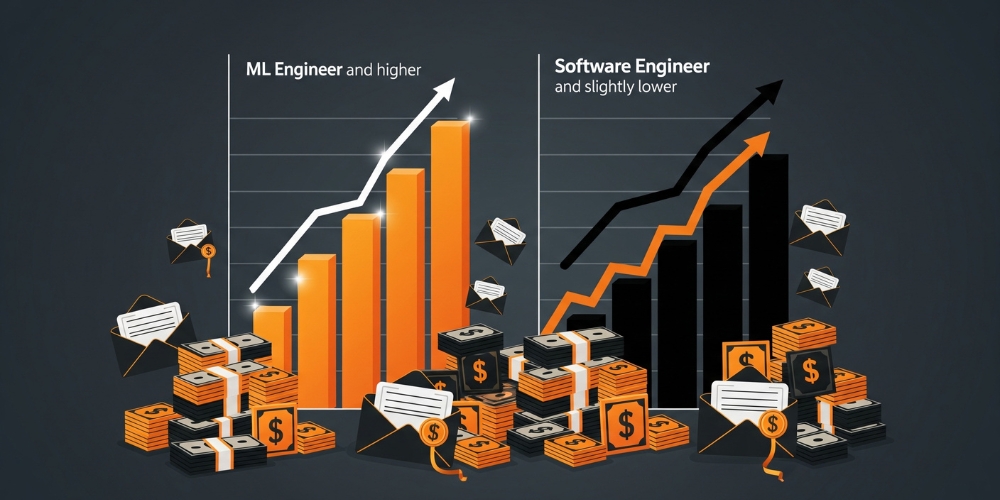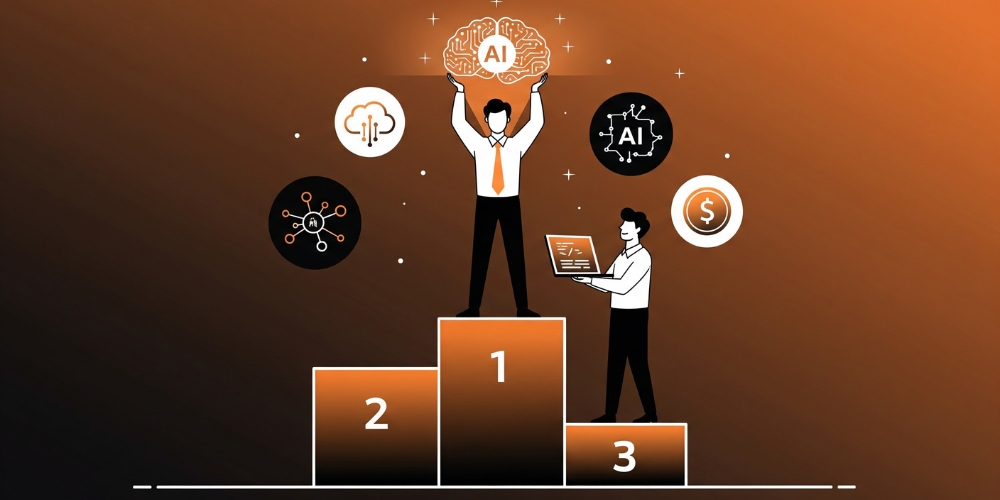
TL;DR
- ML engineers usually earn more than software engineers in 2025.
- Pay gap driven by scarce skills, AI’s business value, and tech giant bidding wars.
- Senior SWE or AI‑hybrid roles can match or beat ML pay.
- Machine learning jobs offer faster, early‑career earning growth.
- SWE can pivot to ML for higher pay and growth potential.
The question “Do ML engineers make more than software engineers?” is one we hear all the time, from bootcamp grads to experienced coders pondering a pivot into AI. With booming demand for machine learning jobs in 2025 and top firms offering ever-larger pay packages, the gap seems clear, but how big is it really?
Well, the data shows a consistent pattern: machine learning engineer entry level and mid-career roles offer higher base and total compensation than typical software engineer jobs, thanks to the premium placed on AI skills. But it’s not always a one-way street, especially in certain geographies or specialties. Let’s break it all down clearly.
Salary Guess Challenge
In 2025, what’s the average total compensation for a machine learning engineer in the U.S.?
ML Engineer vs Software Engineer: What’s the Difference?

Core Responsibilities
- A machine learning engineer focuses on building, training, and deploying algorithms. They often work on model performance, tuning, production pipelines, and ML infrastructure engineer challenges.
- A software engineer builds scalable software systems, APIs, user interfaces, and backend services. They solve architectural and logic problems across full-stack or backend layers.
- Some roles straddle both: software engineer machine learning, or MLOps salary roles require both coding and ML system skills.
Required Skills & Background
- ML engineers typically hold expertise in statistics, machine learning, and software engineering, data pipelines, model deployment, and cloud frameworks.
- Software engineers may specialize in languages, frameworks, scalability, microservices, CI/CD, but without the algorithmic modeling component.
- Entry into ML often requires more specialized learning: so machine learning engineer entry level roles generally expect machine learning coursework or projects on top of coding ability.
Examples of Jobs & Titles
- Meta machine learning engineer or machine learning engineer meta roles may demand deep ML knowledge plus software architecture skills, and are among the most lucrative in the field.
- Meanwhile, classic software engineer jobs in Minnesota or other states offer stable pay and well-defined career progression, though typically not at ML-engineer levels unless the project is AI‑related.
Career Path Differences
- Software engineer progression: junior → mid → senior → lead → engineering manager.
- ML engineering often goes: junior → senior ML engineer → ML architect → AI leader. Promotions can be faster in AI‑heavy organizations hungry for technical depth.
ML Engineer vs Software Engineer: Skill Sorter
Drag each skill into the correct column, then click Submit to check your answers.
Skills
ML Engineer
Software Engineer
2025 Salary Data: ML Engineer vs Software Engineer

USA Overview
Here’s a breakdown of AI/ML engineer salaries in the U.S. for 2025:
- The average machine learning engineer base salary in the U.S. for 2025 is the tune of about $158,147, with additional cash compensation around $44,280, resulting in a total average of $202,427.
- In contrast, the average software engineer salary in 2025 is approximately $112,165 base, plus $26–49K additional pay, so total comp generally lands in the $130K–160K range.
Experience-Level Breakdown
For machine learning jobs, entry-level (0 –1 year) roles start around $118K, rising to $134K at 2–3 years, and $156K at 4–6 years.
For software engineering, mid-level engineers (5 years experience) in 2025 make between $120K–173K, with seniors earning $205K base.
Market Spread & Top Firms
Job postings for ML engineers often advertise compensation ranges: min ~$137K, mid ~$176K, and max ~$214K.
At FAANG‑scale companies, ML roles can fetch even higher rewards. For example:
- Google ML engineers: base ~$177K, total up to ~$281K.
- Apple ML roles: base ~$193K, total comp up to ~$300K.
- Meta ML positions: base ~$123K with total pay around ~$152K.
Software engineers at large firms can still earn very well: Microsoft senior engineers and AI-focused staff receive total compensation packages regularly exceeding $300K, with elite positions at Meta or OpenAI reaching millions per year.
2025 Salary Data: ML Engineer vs Software Engineer
Why ML Engineers Are (Usually) Paid More

1. Specialized & Scarce Skillset
Machine learning jobs demand proficiency in statistical modeling, working with data pipelines, application of frameworks like TensorFlow or PyTorch, and experience with deployment and ML infrastructure engineer challenges. That combo is rarer than generalist coding skills, pushing up salaries.
2. High Business Impact
ML roles often drive revenue-impacting products such as recommendation systems, AI tools, forecasting, and automation. Companies see tangible ROI from ML models, so they’re willing to invest heavily in ML talent.
3. Competitive Market & Tech Giants’ Bidding Wars
As AI becomes core to product strategy, Meta, Microsoft, Google, Apple, and even startups are competing hard for ML talent. Recent reports show ML talent being offered multi-million dollar contracts, base pay exceeding $300K, and total comp in the $400K+ range for elite roles.
4. Roles Evolving Toward MLOps & AI Systems
Many ML engineers take on roles akin to software engineer, machine learning, MLOps salary, or ML infrastructure engineer. These hybrid roles require both traditional software engineering skills and ML-specific expertise, making them doubly valuable and better compensated.
5. Faster Progression in AI-Driven Organizations
In companies heavily focused on AI, ML engineers often move faster up the career ladder: junior → senior ML engineer → ML architect → AI/ML leadership. That path can bring quicker jumps in pay relative to a traditional SWE track.
When Do Software Engineers Earn More?

Despite the general trend that ML engineers earn more, there are clear scenarios where software engineer roles can exceed ML pay:
Senior-Level SWE at Big Tech
- At Microsoft, senior software engineers (including AI software engineers) earn base up to $284K, while LinkedIn ML engineers receive total comp up to $336K.
- Software engineer positions at Apple and Palantir pay strong base ranges: Palantir SWE base spans $155K–240K, rivaling ML roles.
High-Impact, Large-Scale Engineering Projects
Positions in backbone systems, DevOps, or MLOps infrastructure sometimes pay as well or more than mid-tier ML engineers. These roles require deep coding expertise and system design skills.
Equity & Stock-Based Packages
Senior software engineer jobs in Minnesota or in scaled companies with extensive equity programs can offer compensations that match or exceed ML roles, especially with vesting equity or performance shares.
Specialized or Leadership Paths
Senior software engineers who become staff engineers, principal engineers, or engineering managers in major tech firms often eclipse ML pay, particularly in AI-focused product areas.
Community Insight:
From Reddit’s r/cscareerquestions:
“At Snap L5 SWE would be around 550k, then MLE would be at 580k.”
This reflects real-world pay bands where software engineer, machine learning crossover, and senior SWE roles can be competitive with ML levels.
Career Outlook: Which Role Is Growing Faster in 2025?

Machine Learning Engineer Growth
- The global machine learning jobs sector is projected to reach $113.1 billion in 2025, growing to $503.4 billion by 2030.
- Employment is rising fast. There are 1.6 million ML engineers globally, up by 219,000 in just a year.
According to the World Economic Forum’s Future of Jobs Report 2025, AI and Machine Learning Specialists rank among the fastest-growing tech roles, alongside Big Data and Fintech roles.
Software Engineering Outlook
- Software engineering roles continue to grow steadily: projected 17% job growth from 2023 to 2033, adding ~327,900 new jobs.
- Demand focuses on experienced SWE and those with AI/ML fluency, as traditional entry-level hiring is slowing due to automation and increased expectations.
Comparative Growth
| Role | Growth Rate (2023–2030/33) | Key Drivers & Trends |
| Machine Learning Engineer | Extremely high. Demand accelerating now, and future projected growth strong | Explosion in AI deployments, MLOps roles, business impact, ML skill premium |
| Software Engineer (general/AI hybrid) | Growth steady (~17%) | Core infrastructure, AI-integrated projects, transformation of SWE roles into AI makers |
Role Convergence & Adaptation
- Roles like software engineer, machine learning, MLOps salary, and ML infrastructure engineer are blending traditional SWE and ML skill sets, unlocking high-growth trajectories and compensation.
- However, entry-level software engineers are most threatened by automation: layoffs of junior roles are increasing, and companies are hiring fewer new grads unless they offer AI skills or coding creativity.
Action Steps Based on Outlook
- If you’re targeting rapid growth and high pay: leveling up into ML/AI-focused SWE roles or switching to full ML engineering is a fast track.
- If you’re a senior SWE: continuing in high-scale, AI-enhanced infrastructure or leadership tracks can earn you compensation that competes strongly with ML roles.
- For entry-level professionals: bridging early into machine learning engineer entry level roles gives a stronger career position than general software-only paths.
Career Outlook: Which Role Is Growing Faster in 2025?
Click start to see which role races ahead in growth.
Conclusion
So, do ML engineers make more than software engineers? For 2025, the data says yes, most of the time. Whether it’s a machine learning engineer entry level role or a senior position like ML infrastructure engineer, the average pay is significantly higher than typical software engineer jobs. The driving factors? Scarcity of talent, the direct business value of AI, and competitive bidding wars from tech giants.
But this isn’t the full story. In certain cases, especially at the senior level, in leadership positions, or in companies with generous equity, software engineer machine learning hybrid roles, or even pure SWE positions can surpass ML pay. The deciding factor is often not the job title itself, but the mix of skills, the scale of the company, and the strategic importance of your work.
FAQs
- Strengthening math and statistics foundations.
- Gaining hands‑on experience with ML libraries.
- Working on real projects, either personal or in‑house, related to machine learning and software engineering.




